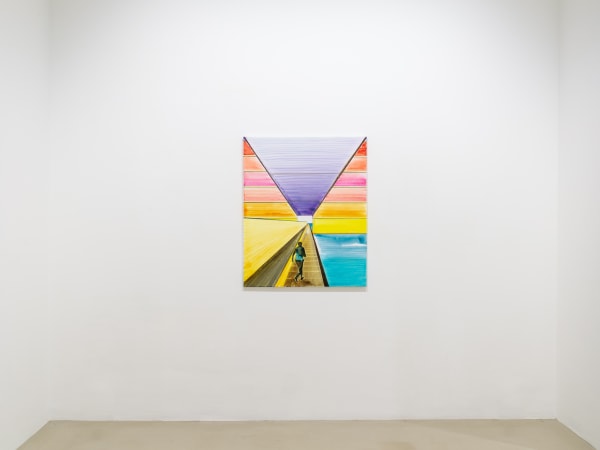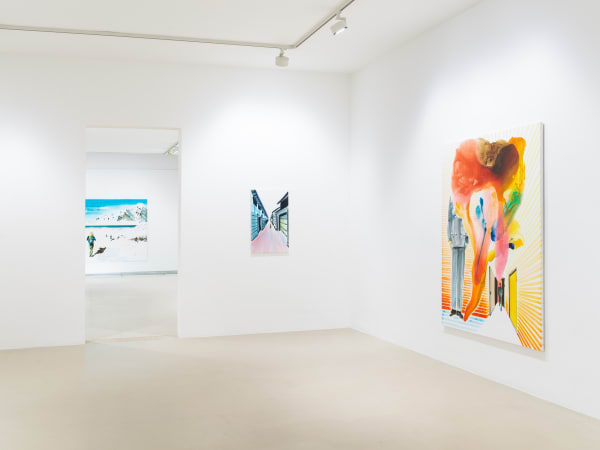JOHN KØRNER: open the door
Past exhibition
Overview
KETELEER GALLERY is very pleased to introduce Open the Door, the first exhibition by John Kørner with the gallery. Since his start at the Royal academy of Fine Arts in 1992, John Kørner created numerous impressive paintings and objects (like his famous egg-shaped ‘Problems’) as well as enormous installations in which the fragmentary universe of his paintings is brought to life in a 3D-experience people can walk or even climb through.
Press release
One can easily recognise John Kørner’s painting from a distance. Each tableau is a brightly – nearly luminescent – coloured scene of transparent layers of acrylic paint that take us to a world in which we often have to look twice to know where we’re standing. The works look like watercolour sketches, but beyond that first impression – the seemingly nonchalant – we clearly see a lot of control in the light touches of colour. The paint is allowed to live, spread out and dry in stains, but everything remains in service to the image and a certain degree of structure. Kørner’s style feels a bit Japanese in its playfulness, but also in not overworking things: a lot of space is left untouched, white, turning the void into an object, a shape for us to fill in. His intuitive brushstrokes are a bit reminiscent of the Zen Buddhist ensō circle, a circle which is drawn in a single swift movement of the wrist, leaving a unique, ineffaceable trace of the person who put it on paper. It’s a spiritual practice, a calligraphic symbol of elegance, movement, the universe: the everything and the void, but also of the beauty and creative force of imperfection.
However, Kørner’s works are at the same time very ‘full’. Different perspectives and levels of impressions are brought together in the same two-dimensional plane, emphasizing in a striking manner/strikingly how our experience is never limited to that of the place and the moment we are in right now. Memories and the unconscious penetrate the paintings, showing us Kørner’s strong expressionist side: he portrays the experienced, the felt world, a world which sometimes results in nearly psychedelic Fata Morganas.
Throughout Kørner’s oeuvre, but especially in this exhibition, we come across images in which human figures are on their way to something, are undertaking a journey of some sort and are confronted with the awe-inspiring vastness of nature or with stifling corridors, staircases, doors and other situations that help us on our way, point us in a direction or form an obstacle. It seems that man needs to always keep moving in order to keep his balance, something beyond the horizon inspires us to go and discover what the path might bring us. Or as Charles Taylor might put it: man strives towards something which exceeds the place he is in now. It’s only in the interaction with what’s outside of us, the other and the unknown that we find ourselves and are able to build an internal network of new connections. A sort of intuitive urge for epigenetic self-perfection one could say.
The abstract and the figurative always work hand in hand in Kørner’s world, a translation perhaps of our analytically inclined mind being in a constant power play with our direct, felt experience. There’s another type of void to be found in Kørner’s works, ‘holes’: parts that weren’t registered or got lost in the chaos of interpretation, a dreamlike absence of information.
Our distorted point of view, an unstable point of departure – simultaneously locked in our bodies and moving through space and time – is in a constant renegotiation with what surrounds us. Our inescapably subjective perspective deforms that which we see, and that which we see continuously rechallenges that which we think we see. In Kørner’s works, the human figures and the space through which they move seem to melt into one another and maybe in a way, they really do.
Lauren Wiggers, 2020.
John Kørner is a renowned Danish artist and had solo exhibitions in institutions, museums and galeries across the world. A selection of recent exhibitions: Museum Dhondt-Dhaenens, Deurle, BE (2018); EMMA – Espoo, Museum of Modern Art, Espoo, FI (2018). Charlottenborg in Copenhagen, DK (2017); Dunkers Kulturhus, Helsingborg, SE (2016); Munkeruphus, Dronningmølle, DK (2016), Odense, DK (2016), Vejle Kunstmuseum, Vejle, DK (2016), Museum Belvédère, Heerenveen-Oranjewoud, NL (2016), Kastrupgårdsamlingen, Copenhagen, DK (2015), Odsherred Kunstmuseum, Asnæs, DK (2015), Herning Museum of Contemporary Art, Herning, DK(2013), The Workers’ Museum, Copenhagen, DK (2011) and Moderna, Moderna Museet, Stockholm, SE (2005).
His work is part of numerous collections amongst which: Centre National des Arts Plastiques (CNAP), French National Art Collection, FR; ARoS, Århus Museum of Art, DK; Arken, Museum of Modern Art, DK; Royal Museum of Fine Arts, Copenhagen, DK; Tate Gallery, London, UK; The Saatchi Collection, London, UK; Herning Museum of Art, DK; Rubell Family Collection, Miami, USA; Moderna Museet, Stockholm, SE.
Installation Views







